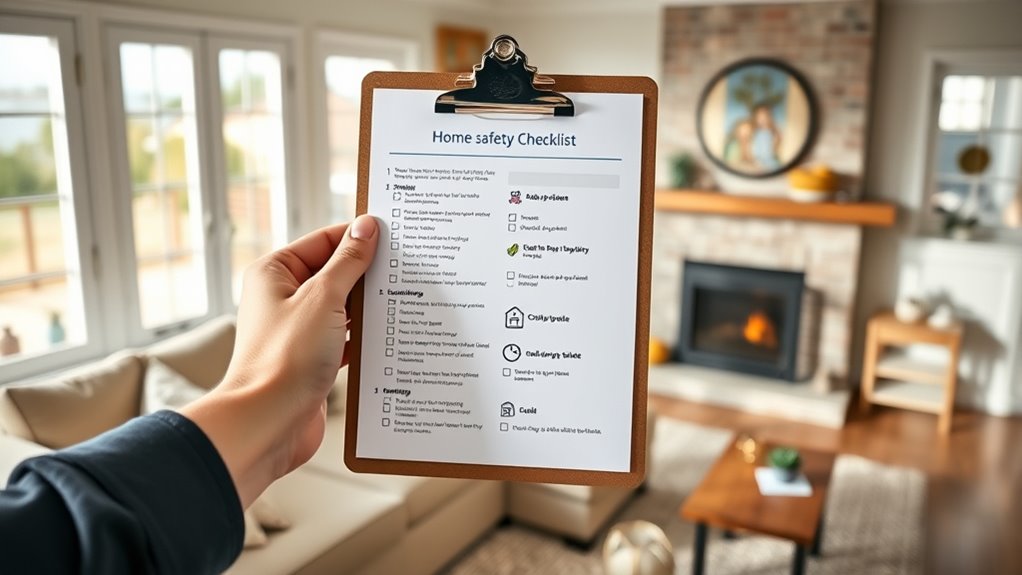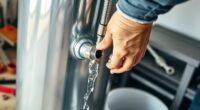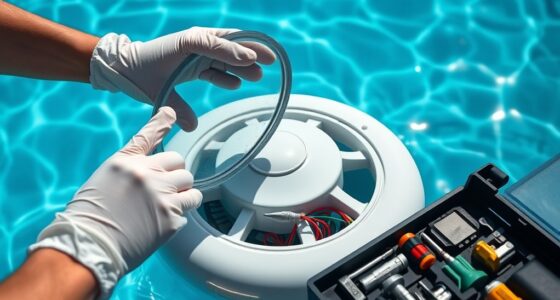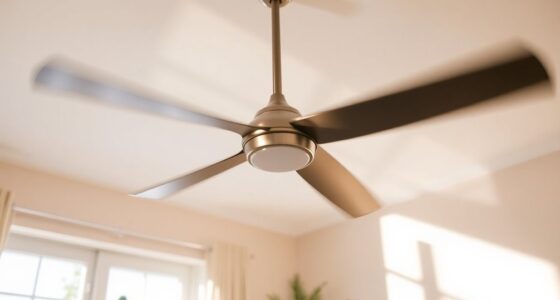To measure your home safety checklist the right way, gather your tools like a flashlight, notepad, and measuring tape. Review and customize your list to match your home’s features. Walk through each space systematically, inspecting safety devices, hazards, and potential risks. Document your findings clearly and prioritize areas needing improvement. Regularly update the checklist to keep your home safe. Keep exploring, and you’ll discover effective ways to maintain ongoing safety.
Key Takeaways
- Regularly review and update the checklist to reflect current household hazards and safety standards.
- Use clear, measurable criteria for each safety item, such as device functionality or hazard severity.
- Conduct thorough walkthroughs, documenting specific findings with detailed notes and photographs when possible.
- Track safety data consistently in digital tools, enabling pattern recognition and trend analysis over time.
- Involve family members or safety professionals for objective assessments and to ensure comprehensive coverage.
Gather Necessary Tools and Resources
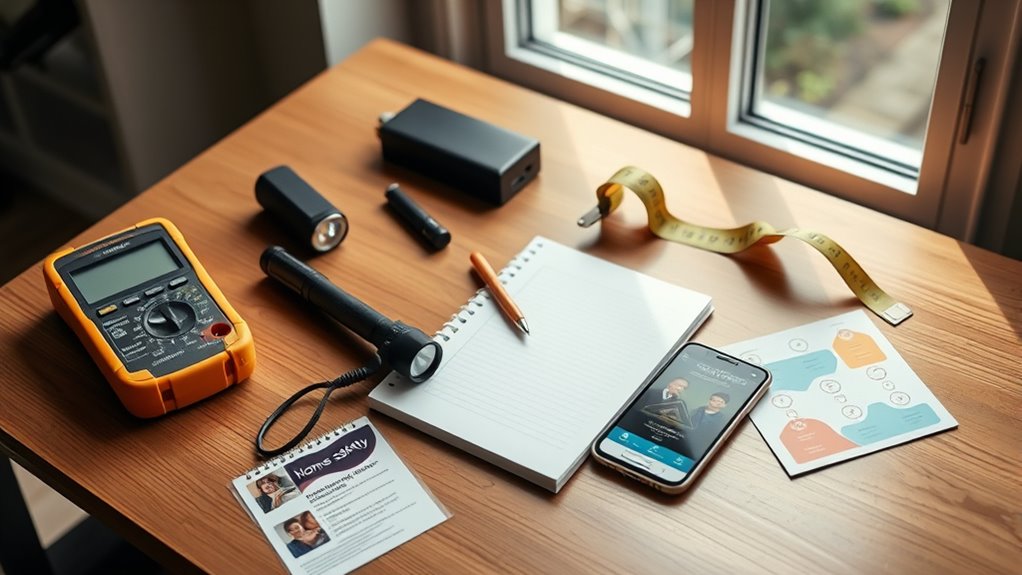
Before you begin your home safety assessment, it’s important to gather all the necessary tools and resources. Start with tools preparation by assembling a flashlight, a measuring tape, a notepad, and a pen. These will help you accurately evaluate each area of your home. Conduct a resource assessment to identify safety devices you already have, like smoke detectors, fire extinguishers, and first aid kits. Make sure to check their condition and note any replacements or upgrades needed. Having everything ready before you start streamlines the process and ensures you don’t overlook any critical safety elements. Being organized from the beginning helps you stay focused and efficient, making your safety assessment thorough and effective. Additionally, consider reviewing your air purifier maintenance to ensure your home’s air quality is also maintained during your safety check.
Review and Customize Your Checklist

Reviewing and customizing your safety checklist guarantees it addresses your home’s specific needs. Start by examining each item and considering whether it applies to your environment. Customization options allow you to add or remove checks based on your household’s unique features, such as children, pets, or specific hazards. This step enhances checklist flexibility, ensuring it remains relevant over time. For example, if you have a pool, include safety measures specific to water hazards. If you’ve recently renovated, update your list to reflect new risks. Tailoring your checklist makes it more effective and easier to follow. Regular reviews ensure it stays current, helping you prioritize safety improvements that truly matter for your home. Incorporating home safety assessments can further help identify overlooked hazards and reinforce your safety measures.
Conduct a Thorough Walkthrough of Your Home

Conducting a thorough walkthrough of your home is essential to identify potential safety hazards that might not be obvious on a checklist. Use inspection techniques like checking for loose handrails, examining electrical cords, and testing smoke detectors. Look for home hazards such as cluttered pathways, unsecured rugs, or exposed wiring. Pay special attention to high-risk areas like kitchens, bathrooms, and stairways. Move slowly through each room, actively inspecting every corner and surface. Don’t rush; this step helps you spot hazards that might be missed in a quick glance. Keep your eyes open for signs of wear or damage that could cause accidents. A detailed walkthrough guarantees you don’t overlook safety issues, making your home safer for everyone. Incorporate home safety assessments into your routine to ensure ongoing vigilance.
Document Your Findings Accurately

To guarantee your safety assessments are useful, you need to document your findings clearly. Use straightforward methods to record all observations precisely, so nothing gets overlooked. Keep your data organized in logs that are easy to review and update as needed. Incorporating necessary cookies can help ensure that your data collection process remains consistent and reliable.
Use Clear Documentation Methods
Using clear documentation methods is essential to guarantee your home safety findings are accurate and easy to understand. By utilizing digital templates, you create a consistent record, reducing errors. Barcode scanning can streamline inventory checks, making data entry quick and precise. To keep things organized, consider this simple approach:
| Item | Observation | Action Needed |
|---|---|---|
| Smoke Detectors | All functional, replace batteries | Schedule replacement |
| Fire Extinguisher | Accessible, expired extinguisher | Replace within a month |
| Windows | Locks functioning properly | No action needed |
| Electrical Outlets | Loose outlets, unsafe wiring | Contact electrician |
This structured method ensures clarity and accuracy, making your safety assessment reliable. Incorporating home safety standards can further improve your evaluation process.
Record All Observations Precisely
Ensuring your observations are recorded precisely is crucial for an accurate home safety assessment. When noting potential home hazards, be specific about their location, size, and condition. Record details about safety devices, such as smoke detectors or fire extinguishers, including whether they are functional and properly placed. Accurate documentation helps you identify patterns or recurring issues and guarantees nothing is overlooked. Use clear, straightforward language and avoid assumptions; note what you see, not what you think. Precise records make it easier to prioritize repairs or upgrades and communicate findings to others involved in safety improvements. By documenting your observations carefully, you create a reliable record that supports a safer, hazard-free home environment.
Maintain Organized Data Logs
Maintaining organized data logs is essential for tracking your home safety progress effectively. Using digital tracking tools allows you to store all your safety observations in one place, making updates simple and accessible. Consistently recording your findings helps identify patterns and areas needing improvement. Data visualization techniques, like charts or graphs, turn raw data into clear visuals, so you can quickly assess safety trends over time. Keeping your logs well-structured ensures you can review past assessments easily and share progress with family members or safety professionals. Regularly updating and reviewing these logs helps you stay proactive, making safety adjustments when necessary. Incorporating expert voice actors in your safety communication can enhance clarity and engagement, ensuring your message resonates effectively. With accurate documentation, you’ll have a thorough view of your home’s safety status, enabling informed decisions and peace of mind.
Prioritize Safety Concerns and Plan Improvements
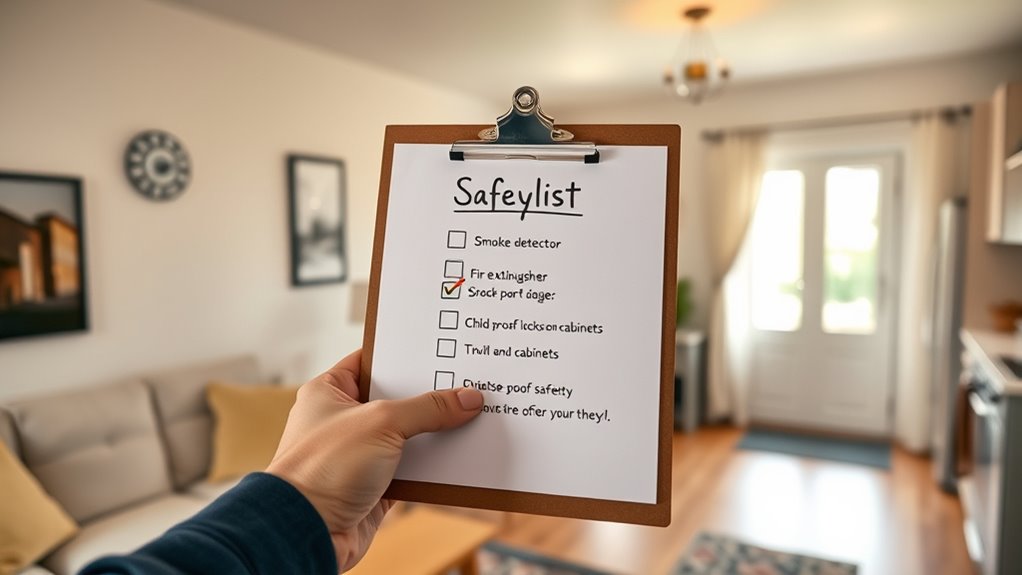
To effectively improve your home’s safety, you need to identify the most critical concerns first. Conduct a thorough risk evaluation to pinpoint hazards that could cause injury or damage. Focus your attention on areas with high risks, such as loose railings or exposed wiring. Incorporate emergency planning by establishing clear protocols for fires, falls, or other emergencies. Prioritizing these safety concerns allows you to allocate resources efficiently and address the most pressing issues promptly. Create an action plan that targets these risks, setting realistic deadlines for repairs and improvements. By systematically analyzing risks and developing emergency plans, you ensure your home becomes safer for everyone. Understanding vibrational energy and its impact on safety can also help you maintain a proactive mindset towards home improvements. This proactive approach lays a strong foundation for ongoing safety enhancements.
Regularly Reassess and Update Your Checklist
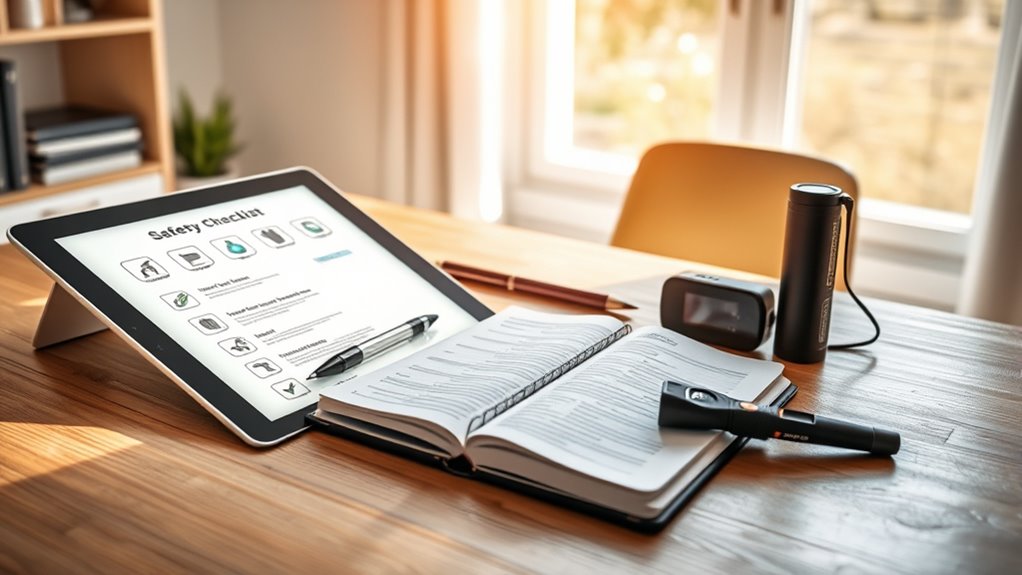
To keep your home safety checklist effective, you need to regularly review and update it. Schedule routine checks to catch new hazards or improvements needed. As your home changes, adjust your checklist to stay ahead of potential risks. Incorporating positive thinking strategies can help you approach safety updates with a proactive mindset and foster a more vigilant attitude.
Schedule Routine Checks
Scheduling routine checks guarantees your home safety remains effective over time. Regularly reviewing your safety checklist helps you identify new hazards and ensure existing measures work. During these inspections, consider your home automation systems to verify they’re functioning properly. Update your emergency preparedness plans to reflect any changes in your household or environment. Keep these tips in mind:
- Test smoke and carbon monoxide detectors monthly
- Inspect home automation devices for updates or malfunctions
- Check fire extinguishers and first aid supplies
- Review escape routes and emergency contacts
- Adjust safety measures based on recent changes or new risks
Additionally, stay informed about AI Discoveries that could influence future safety technologies in your home.
Adjust for Changes
Regularly reassessing and updating your safety checklist guarantees it stays relevant as your home and circumstances change. Seasonal adjustments are essential—what’s safe in summer might not be enough in winter, like adding extra fire safety measures or checking heating systems. It’s also important to review your emergency preparedness plan after significant life events or home improvements. As your family grows or moves, update your checklist to reflect new hazards or safety needs. Stay aware of potential risks that arise over time, such as loose railings or outdated smoke detectors. By consistently modifying your safety measures, you ensure your home remains a secure environment. Regular updates help you address evolving risks and keep safety top of mind through every season and life change.
Frequently Asked Questions
How Often Should I Perform a Home Safety Check?
You should perform a home safety check at least once a month. During this check, make certain your smoke detectors are working properly and test your home fire safety measures. Regularly inspecting smoke detectors and other safety devices helps catch issues early, reducing fire risks. Don’t forget to replace batteries annually and clean detectors to maintain their effectiveness, keeping you and your family safe from potential home fire hazards.
What Common Safety Hazards Are Often Overlooked?
You often overlook fire hazards like lint buildup in dryers or faulty wiring, which can cause fires. Electrical safety is also critical but frequently ignored, such as overloaded outlets or missing outlet covers. Regularly check for these hazards during your safety inspections. Ensuring fire safety measures and electrical systems are in good condition helps protect your home and loved ones from preventable accidents.
Can I Use a Digital App for Safety Assessments?
Yes, you can definitely use digital apps for safety assessments. They streamline your safety checks, simplify scanning, and notably save time. Digital apps offer detailed data, prompt reminders, and precise assessments, making your home safer. With user-friendly interfaces, you can quickly conduct safety evaluations, track hazards, and ensure nothing gets overlooked. Embrace these innovative tools to improve your home safety, making assessments easier, faster, and more thorough.
How Do I Involve Children in Safety Evaluations?
You involve children in safety evaluations by making it fun and engaging, encouraging their participation in child safety checks. Explain safety rules simply, ask for their ideas, and give them small responsibilities like checking for hazards or testing smoke alarms. This family involvement helps children understand safety, builds awareness, and fosters a sense of responsibility. Keep the process positive and supportive to ensure they stay interested and learn effectively.
What Signs Indicate Immediate Safety Repairs Are Needed?
When your home whispers danger, it’s time to listen. Signs like charred outlets, flickering lights, or sparks flying near electrical cords signal urgent repairs. Fire hazards lurk where wires are frayed or overloaded, and electrical safety is compromised. If you notice burning smells, scorch marks, or loose fixtures, act fast. These warning signs are your home’s cry for help, guiding you to fix hazards before they ignite disaster.
Conclusion
By following these steps, you’ll turn your home into a fortress of safety, not just a building. Regularly updating your checklist keeps your safety net strong, catching potential hazards before they become crises. Think of it as tending a garden—you must nurture and prune to keep it thriving. With vigilance and care, you’ll guarantee your home remains a sanctuary, where safety blossoms and peace of mind grows effortlessly.
